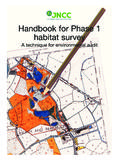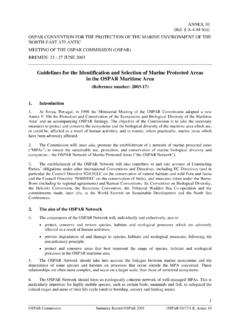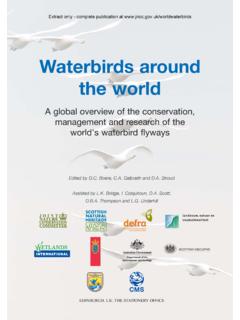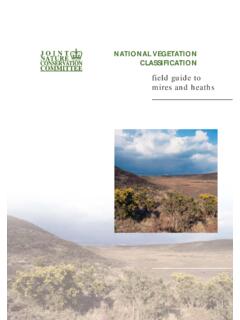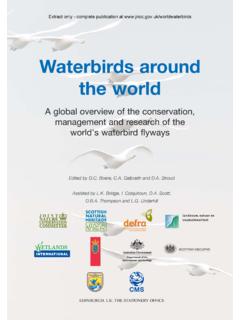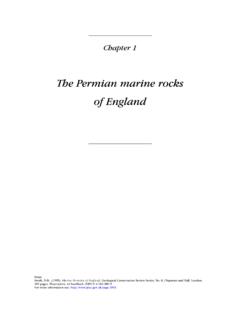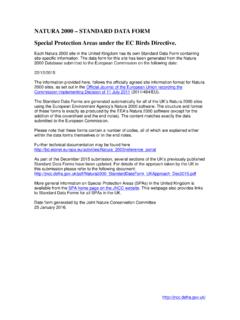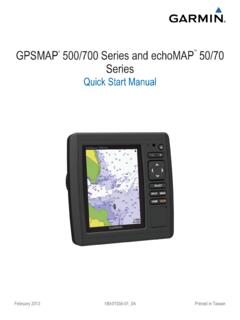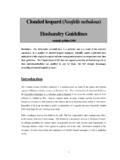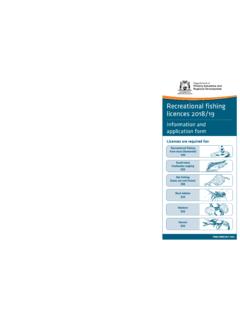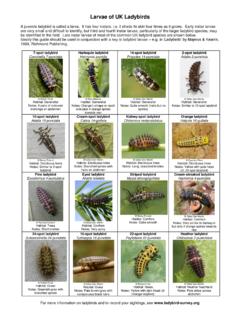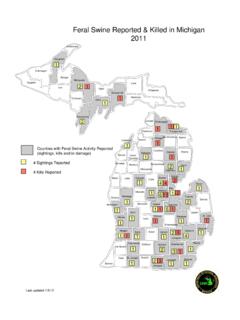Transcription of Analysis of harbour porpoise sightings data - JNCC
1 Analysis of harbour porpoise sightings data in relation to area-based conservation. Mark. Bravington, David Borchers and Simon Northridge Executive summary June 2010 For further information on XXXXXXXX 2 Analysis of harbour porpoise sightings data in relation to area-based conservation. Mark. Bravington, David Borchers and Simon Northridge Executive summary The analyses reported here are necessarily partly exploratory, given the limited person-time available and the size and complexity of the dataset. It has been possible to draw only weak conclusions about areas of regular high harbour porpoise density (referred to as hotspots for brevity). While it is not clear whether further method development will locate such areas more reliably (they may not be there to locate), it is clear that methodological development will lead to more reliable inferences about them.
2 data were inadequate to examine calf-adult ratios. Evidence of hotspots: For the most part, evidence of persistent areas of high porpoise density are lacking. The strongest suggestion of a hotspot is in the south Irish Sea, with weaker indications of hotspots in the central Irish Sea and east of the Moray Firth and Firth of Forth. Recommendations Investigate further the possible hotspots in the Irish Sea and off Eastern Britain. : Develop and apply methods that address the deficiencies highlighted in this Analysis , to make optimal use of the data . Introduction The EC Habitats Directive requires member states to consider special areas of conservation (SACs) for all species listed on Annex II. The Annex includes both bottlenose dolphins (Tursiops truncatus) and harbour porpoises (Phocoena phocoena). The former inhabit relatively discrete areas of coastal water in several parts of the European Union, but the latter are much more widely distributed, and there is little evidence of residence in any particular area, nor are there any obvious discrete areas where densities are high enough to suggest a significant proportion of the population is resident, unless such areas were to extend to ICES Division scale.
3 One of the best sources of information on the distribution of porpoises in north-western European waters is the Joint Cetacean Database a database consisting of over 20 years of sightings data from three major sources. These are the EC funded SCANS project1, the European Seabirds at Sea consortium, which also maintains records of cetacean sightings , and the Sea Watch foundation database of sightings collected from a wide variety of sources since 1979. data from these three sources have been collated into a single database, with a common format. Together, these datasets comprise a unique and valuable source of information about the distribution of harbour porpoise in waters around Britain. Note, however, the Sea Watch data were not available in time for inclusion in the analyses reported here. 1 Distribution and Abundance of the harbour porpoise and other small cetaceans in the North Sea and adjacent waters.
4 LIFE 92-2/UK/027 3 The objective of the current study was to apply some recently developed statistical modelling techniques to these data in order to look for areas of high porpoise density that might be suitable as SACs. It is important to understand that although these data have been collated in a common format, the means of data collection have been quite varied. A wide variety of platforms has been used, so that observer eye height and vessel speed, for example, are highly variable throughout the database. It is also known that porpoises react aversively to vessels, and the degree of this reaction will depend on certain characteristics of the vessel, such as the amount of noise it makes. It is also known that there is considerable variability among observers in detecting porpoises. These and other factors can have order of magnitude effects on sightings rates, and they cannot be controlled for in such wide-scale surveys.
5 Whereas it might be hoped that such effects would not bias any interpretation of the overall sightings rates of porpoises, a casual examination of the data would reveal that this is highly unlikely. Many vessels and observers, for example, focus their activities on relatively small areas or repetitive transects, while some platforms or observers are only active for earlier or later parts of the survey period. There is therefore a real concern that any detailed simple examination of the sightings data in the JCD could be significantly biased by the sightings efficiencies of different platforms or observers. To address such issues, Bravington (2000a) has developed a suite of statistical tools that are intended to model sightings rates of cetaceans spatially and with respect to covariates such as platform, observer and environmental conditions.
6 We have used these tools here to examine data in the JCD in order to try to determine whether there are any areas within UK waters that show consistently high porpoise densities. 2 Methods data The JCD was initially compiled in 1999, and was based on the existing SCANS data set, the ESAS 2 data set (comprising European Seabirds at Sea data up to 1998) and a version of the Sea Watch Foundation database. It was decided early in the present project to try to work with the latest data available, and accordingly the ESAS-3 dataset was successfully updated to JCD format with data up to the year 2000. Consultations with the Sea Watch Foundation indicated that there were some serious inconsistencies within the SWF database as supplied to the JCD, but that these were being addressed and corrected. It was initially anticipated that the SWF database would be corrected and updated within the JCD by January 2002 It is important to understand that whereas errors in a sightings database may not be significant for broad-brush or large scale geographical overviews, the statistical tools we were using have a far smaller tolerance of errors.
7 Small errors in time or location data can seriously affect the Analysis , either causing the programme to crash, or producing nonsensical results. This in turn can lead to a lot of wasted time by the analyst trying to weed out problem records or batches of records. Given the short length of time available for Analysis it did not make sense for us to proceed with an attempted Analysis of a dataset which was know to have a large number of inconsistencies. We therefore opted to wait for the revised SWF dataset, and to proceed in the interim with the Analysis based solely on the other datasets. Unfortunately, unforeseen problems with the SWF database meant that an updated version of these data was not received until after the termination of the current contract, so that to date no analyses have been performed on the SWF part of the JCD.
8 4 Working with the remaining data , we found that even here there were a number of unforeseen data problems that hindered Analysis . Two major data error types within the updated JCD were apparent. First, 478 out of 355,144 records were found to have effort start times that were later than their end times. Secondly, some 659 records were found to have start times that preceded the time at which the previous effort leg was supposed to have ended. The origin of these data anomalies could not be determined, but some were simple typographical errors at data entry, while others, especially of the second type, may have been introduced during data transformation from ESAS to JCD format. It was not possible to comb through these 1137 records to try to fix them all manually, so that the Analysis had to proceed by removing all such records and adjacent ones on the same sighting trip during the same day.
9 This meant that 15% of the total data had to be abandoned during Analysis . This problem highlights the issue of data maintenance. The JCD in total represents an enormous dataset, which is also a very rich source of information. However, it also represents an enormous house-keeping task to ensure that all of the hundreds of thousands of records are error-free. Errors may be introduced at any stage to such a database, and even very thorough checks will inevitably miss some types of error. This is especially a problem where a new type of Analysis is being attempted, and where errors that had been missed as unimportant to the working of previous analyses suddenly become highly significant. Considerable analytical time was therefore spent in trying to uncover and remove these errors in timing which had not previously been picked up in other analyses.
10 This also helps to explain why we were reluctant to attempt any analyses on the SWF part of the dataset before it had been corrected to the satisfaction of the SWF data manager. Despite these data problems we were still able to run the statistical analyses with over 300,000 effort records (typically 10 minutes of observation time, or over 50,000 hours of observation in all). Statistical analyses. Pseudotime Our Analysis followed that of Bravington (2000a, 2000b). With this approach, the amount of effort spent searching before detecting an animal or group of animals is the key to estimation of local density. For a given level of search effort, if you searched for a long time before detecting an animal, the local density is estimated to be low. Conversely, if little time was spent searching before making the next sighting, the local density is estimated to be high.

